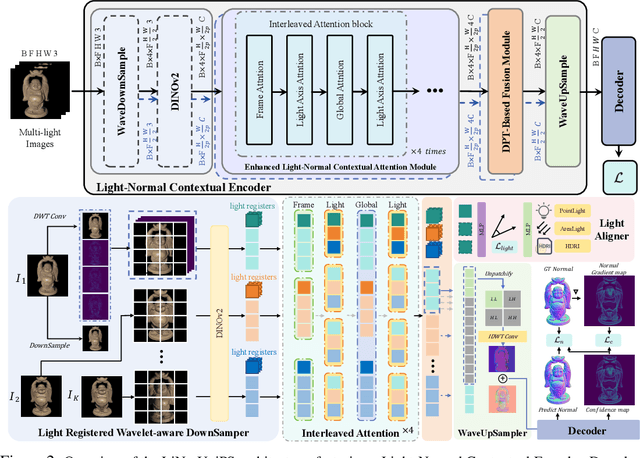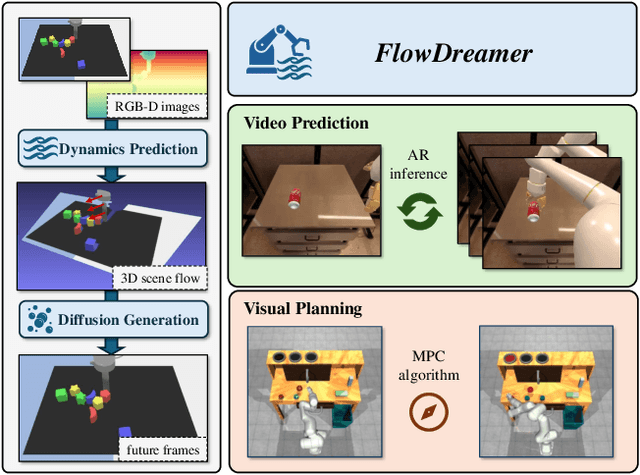Yikai Wang
EGTM: Event-guided Efficient Turbulence Mitigation
Sep 04, 2025Abstract:Turbulence mitigation (TM) aims to remove the stochastic distortions and blurs introduced by atmospheric turbulence into frame cameras. Existing state-of-the-art deep-learning TM methods extract turbulence cues from multiple degraded frames to find the so-called "lucky'', not distorted patch, for "lucky fusion''. However, it requires high-capacity network to learn from coarse-grained turbulence dynamics between synchronous frames with limited frame-rate, thus fall short in computational and storage efficiency. Event cameras, with microsecond-level temporal resolution, have the potential to fundamentally address this bottleneck with efficient sparse and asynchronous imaging mechanism. In light of this, we (i) present the fundamental \textbf{``event-lucky insight''} to reveal the correlation between turbulence distortions and inverse spatiotemporal distribution of event streams. Then, build upon this insight, we (ii) propose a novel EGTM framework that extracts pixel-level reliable turbulence-free guidance from the explicit but noisy turbulent events for temporal lucky fusion. Moreover, we (iii) build the first turbulence data acquisition system to contribute the first real-world event-driven TM dataset. Extensive experimental results demonstrate that our approach significantly surpass the existing SOTA TM method by 710 times, 214 times and 224 times in model size, inference latency and model complexity respectively, while achieving the state-of-the-art in restoration quality (+0.94 PSNR and +0.08 SSIM) on our real-world EGTM dataset. This demonstrating the great efficiency merit of introducing event modality into TM task. Demo code and data have been uploaded in supplementary material and will be released once accepted.
Matrix-3D: Omnidirectional Explorable 3D World Generation
Aug 11, 2025Abstract:Explorable 3D world generation from a single image or text prompt forms a cornerstone of spatial intelligence. Recent works utilize video model to achieve wide-scope and generalizable 3D world generation. However, existing approaches often suffer from a limited scope in the generated scenes. In this work, we propose Matrix-3D, a framework that utilize panoramic representation for wide-coverage omnidirectional explorable 3D world generation that combines conditional video generation and panoramic 3D reconstruction. We first train a trajectory-guided panoramic video diffusion model that employs scene mesh renders as condition, to enable high-quality and geometrically consistent scene video generation. To lift the panorama scene video to 3D world, we propose two separate methods: (1) a feed-forward large panorama reconstruction model for rapid 3D scene reconstruction and (2) an optimization-based pipeline for accurate and detailed 3D scene reconstruction. To facilitate effective training, we also introduce the Matrix-Pano dataset, the first large-scale synthetic collection comprising 116K high-quality static panoramic video sequences with depth and trajectory annotations. Extensive experiments demonstrate that our proposed framework achieves state-of-the-art performance in panoramic video generation and 3D world generation. See more in https://matrix-3d.github.io.
Ultra3D: Efficient and High-Fidelity 3D Generation with Part Attention
Jul 23, 2025Abstract:Recent advances in sparse voxel representations have significantly improved the quality of 3D content generation, enabling high-resolution modeling with fine-grained geometry. However, existing frameworks suffer from severe computational inefficiencies due to the quadratic complexity of attention mechanisms in their two-stage diffusion pipelines. In this work, we propose Ultra3D, an efficient 3D generation framework that significantly accelerates sparse voxel modeling without compromising quality. Our method leverages the compact VecSet representation to efficiently generate a coarse object layout in the first stage, reducing token count and accelerating voxel coordinate prediction. To refine per-voxel latent features in the second stage, we introduce Part Attention, a geometry-aware localized attention mechanism that restricts attention computation within semantically consistent part regions. This design preserves structural continuity while avoiding unnecessary global attention, achieving up to 6.7x speed-up in latent generation. To support this mechanism, we construct a scalable part annotation pipeline that converts raw meshes into part-labeled sparse voxels. Extensive experiments demonstrate that Ultra3D supports high-resolution 3D generation at 1024 resolution and achieves state-of-the-art performance in both visual fidelity and user preference.
Spatial-Temporal Aware Visuomotor Diffusion Policy Learning
Jul 09, 2025Abstract:Visual imitation learning is effective for robots to learn versatile tasks. However, many existing methods rely on behavior cloning with supervised historical trajectories, limiting their 3D spatial and 4D spatiotemporal awareness. Consequently, these methods struggle to capture the 3D structures and 4D spatiotemporal relationships necessary for real-world deployment. In this work, we propose 4D Diffusion Policy (DP4), a novel visual imitation learning method that incorporates spatiotemporal awareness into diffusion-based policies. Unlike traditional approaches that rely on trajectory cloning, DP4 leverages a dynamic Gaussian world model to guide the learning of 3D spatial and 4D spatiotemporal perceptions from interactive environments. Our method constructs the current 3D scene from a single-view RGB-D observation and predicts the future 3D scene, optimizing trajectory generation by explicitly modeling both spatial and temporal dependencies. Extensive experiments across 17 simulation tasks with 173 variants and 3 real-world robotic tasks demonstrate that the 4D Diffusion Policy (DP4) outperforms baseline methods, improving the average simulation task success rate by 16.4% (Adroit), 14% (DexArt), and 6.45% (RLBench), and the average real-world robotic task success rate by 8.6%.
Light of Normals: Unified Feature Representation for Universal Photometric Stereo
Jun 24, 2025



Abstract:Universal photometric stereo (PS) aims to recover high-quality surface normals from objects under arbitrary lighting conditions without relying on specific illumination models. Despite recent advances such as SDM-UniPS and Uni MS-PS, two fundamental challenges persist: 1) the deep coupling between varying illumination and surface normal features, where ambiguity in observed intensity makes it difficult to determine whether brightness variations stem from lighting changes or surface orientation; and 2) the preservation of high-frequency geometric details in complex surfaces, where intricate geometries create self-shadowing, inter-reflections, and subtle normal variations that conventional feature processing operations struggle to capture accurately.
LocoTouch: Learning Dexterous Quadrupedal Transport with Tactile Sensing
May 29, 2025Abstract:Quadrupedal robots have demonstrated remarkable agility and robustness in traversing complex terrains. However, they remain limited in performing object interactions that require sustained contact. In this work, we present LocoTouch, a system that equips quadrupedal robots with tactile sensing to address a challenging task in this category: long-distance transport of unsecured cylindrical objects, which typically requires custom mounting mechanisms to maintain stability. For efficient large-area tactile sensing, we design a high-density distributed tactile sensor array that covers the entire back of the robot. To effectively leverage tactile feedback for locomotion control, we develop a simulation environment with high-fidelity tactile signals, and train tactile-aware transport policies using a two-stage learning pipeline. Furthermore, we design a novel reward function to promote stable, symmetric, and frequency-adaptive locomotion gaits. After training in simulation, LocoTouch transfers zero-shot to the real world, reliably balancing and transporting a wide range of unsecured, cylindrical everyday objects with broadly varying sizes and weights. Thanks to the responsiveness of the tactile sensor and the adaptive gait reward, LocoTouch can robustly balance objects with slippery surfaces over long distances, or even under severe external perturbations.
FlowDreamer: A RGB-D World Model with Flow-based Motion Representations for Robot Manipulation
May 15, 2025



Abstract:This paper investigates training better visual world models for robot manipulation, i.e., models that can predict future visual observations by conditioning on past frames and robot actions. Specifically, we consider world models that operate on RGB-D frames (RGB-D world models). As opposed to canonical approaches that handle dynamics prediction mostly implicitly and reconcile it with visual rendering in a single model, we introduce FlowDreamer, which adopts 3D scene flow as explicit motion representations. FlowDreamer first predicts 3D scene flow from past frame and action conditions with a U-Net, and then a diffusion model will predict the future frame utilizing the scene flow. FlowDreamer is trained end-to-end despite its modularized nature. We conduct experiments on 4 different benchmarks, covering both video prediction and visual planning tasks. The results demonstrate that FlowDreamer achieves better performance compared to other baseline RGB-D world models by 7% on semantic similarity, 11% on pixel quality, and 6% on success rate in various robot manipulation domains.
Video4DGen: Enhancing Video and 4D Generation through Mutual Optimization
Apr 05, 2025Abstract:The advancement of 4D (i.e., sequential 3D) generation opens up new possibilities for lifelike experiences in various applications, where users can explore dynamic objects or characters from any viewpoint. Meanwhile, video generative models are receiving particular attention given their ability to produce realistic and imaginative frames. These models are also observed to exhibit strong 3D consistency, indicating the potential to act as world simulators. In this work, we present Video4DGen, a novel framework that excels in generating 4D representations from single or multiple generated videos as well as generating 4D-guided videos. This framework is pivotal for creating high-fidelity virtual contents that maintain both spatial and temporal coherence. The 4D outputs generated by Video4DGen are represented using our proposed Dynamic Gaussian Surfels (DGS), which optimizes time-varying warping functions to transform Gaussian surfels (surface elements) from a static state to a dynamically warped state. We design warped-state geometric regularization and refinements on Gaussian surfels, to preserve the structural integrity and fine-grained appearance details. To perform 4D generation from multiple videos and capture representation across spatial, temporal, and pose dimensions, we design multi-video alignment, root pose optimization, and pose-guided frame sampling strategies. The leveraging of continuous warping fields also enables a precise depiction of pose, motion, and deformation over per-video frames. Further, to improve the overall fidelity from the observation of all camera poses, Video4DGen performs novel-view video generation guided by the 4D content, with the proposed confidence-filtered DGS to enhance the quality of generated sequences. With the ability of 4D and video generation, Video4DGen offers a powerful tool for applications in virtual reality, animation, and beyond.
ReasonGrounder: LVLM-Guided Hierarchical Feature Splatting for Open-Vocabulary 3D Visual Grounding and Reasoning
Mar 30, 2025Abstract:Open-vocabulary 3D visual grounding and reasoning aim to localize objects in a scene based on implicit language descriptions, even when they are occluded. This ability is crucial for tasks such as vision-language navigation and autonomous robotics. However, current methods struggle because they rely heavily on fine-tuning with 3D annotations and mask proposals, which limits their ability to handle diverse semantics and common knowledge required for effective reasoning. In this work, we propose ReasonGrounder, an LVLM-guided framework that uses hierarchical 3D feature Gaussian fields for adaptive grouping based on physical scale, enabling open-vocabulary 3D grounding and reasoning. ReasonGrounder interprets implicit instructions using large vision-language models (LVLM) and localizes occluded objects through 3D Gaussian splatting. By incorporating 2D segmentation masks from the SAM and multi-view CLIP embeddings, ReasonGrounder selects Gaussian groups based on object scale, enabling accurate localization through both explicit and implicit language understanding, even in novel, occluded views. We also contribute ReasoningGD, a new dataset containing over 10K scenes and 2 million annotations for evaluating open-vocabulary 3D grounding and amodal perception under occlusion. Experiments show that ReasonGrounder significantly improves 3D grounding accuracy in real-world scenarios.
FB-4D: Spatial-Temporal Coherent Dynamic 3D Content Generation with Feature Banks
Mar 26, 2025Abstract:With the rapid advancements in diffusion models and 3D generation techniques, dynamic 3D content generation has become a crucial research area. However, achieving high-fidelity 4D (dynamic 3D) generation with strong spatial-temporal consistency remains a challenging task. Inspired by recent findings that pretrained diffusion features capture rich correspondences, we propose FB-4D, a novel 4D generation framework that integrates a Feature Bank mechanism to enhance both spatial and temporal consistency in generated frames. In FB-4D, we store features extracted from previous frames and fuse them into the process of generating subsequent frames, ensuring consistent characteristics across both time and multiple views. To ensure a compact representation, the Feature Bank is updated by a proposed dynamic merging mechanism. Leveraging this Feature Bank, we demonstrate for the first time that generating additional reference sequences through multiple autoregressive iterations can continuously improve generation performance. Experimental results show that FB-4D significantly outperforms existing methods in terms of rendering quality, spatial-temporal consistency, and robustness. It surpasses all multi-view generation tuning-free approaches by a large margin and achieves performance on par with training-based methods.
 Add to Chrome
Add to Chrome Add to Firefox
Add to Firefox Add to Edge
Add to Edge